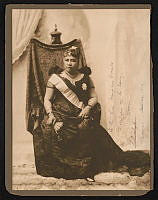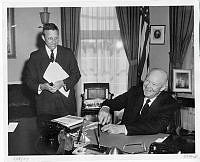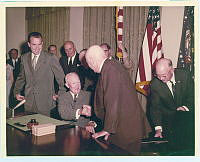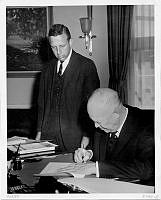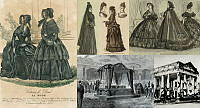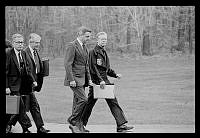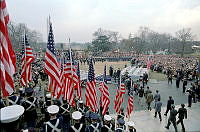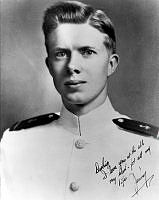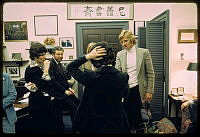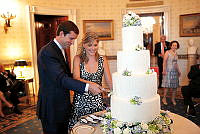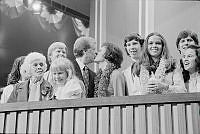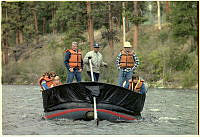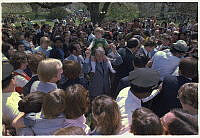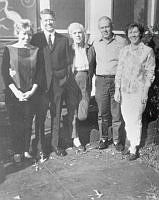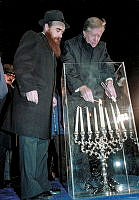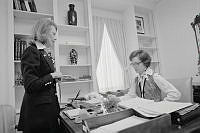The Soldiers' Home: First Presidential Retreat
Copyright © Spring 2006 White House Historical Association. All rights reserved under international copyright conventions. No part of this article may be reproduced or utilized in any form or by any means, electronic or mechanical, including photocopying, recording, or by any information storage and retrieval system, without permission in writing from the publisher. Requests for reprint permissions should be addressed to books@whha.org
Leaving the White House during the summer is an old tradition of the presidents. Those with farms, such as Dwight Eisenhower, or ranches, such as Lyndon B. Johnson and President George W. Bush, go for relaxation in cherished surroundings. Others, notably Richard Nixon, have created retreats, such as his in Florida and California; both Roosevelts went home. Victorian era presidents made use of the Jersey shore, and indeed James A. Garfield died at the beach, toward the close of the summer season 1881.
Presidential vacations are not vacations in the usual sense of the word. The vacationing head of state works the whole time. Moving out of the White House only takes his labors to a new setting, with diversions. If today the move is for a little relaxation, in the early republic it was considered a necessity for health. Thomas Jefferson, the first president to live full-term in the White House, used to stand in the windows of his office — today’s State Dining Room — and look southward as the white fog formed on the marshes where the Ellipse is now. It was considered lethal and gave the area the nickname “White Lot.” Jefferson went home to Monticello, to see to his crops and also to preserve himself.
James Madison went to Montpelier. James Monroe traveled some, but also went to Loudoun County, Virginia, where in the last years of his administration he had James Hoban, builder and rebuilder of the White House, erect for him a beautiful house at his farm Oak Hill. The second Adams returned to Quincy and lived in the Old House, as his ancestral home was known. Andrew Jackson, who was usually frail in health, went home to The Hermitage in Tennessee. Martin Van Buren rented a house in the hills near the present Washington Cathedral. William Henry Harrison, dead before winter’s ice melted after his inauguration carried out no summer plans. John Tyler, Zachary Taylor, and Franklin Pierce took in the springs, enjoying the rambling hotels and healthful waters provided throughout the country for those with the leisure to enjoy them. James K. Polk alone remained at the White House during three summers of his presidency and died only a few months into his retirement, universally believed to be the victim of the white gasses.

The "Old Soldiers' Home," a stereographic slide inaccurately dated 1863. The piazza seen here was extended from the original probably around 1880.
Library of CongressJames Buchanan was the first to engage the Old Soldiers’ Home as a summer retreat and thus made it the first “official” presidential summer house. The president was besieged by the political storms raging all around him. It came to the point that he dreaded dinners at the White House, for northern and southern guests were likely to square off across the table. When he went to the spas, such as Saratoga, the bachelor was so swarmed by hopeful widows that he knew no privacy. He turned for summer shelter to the Soldiers’ Home.
The Old Soldiers’ Home or “Military Asylum” was a campus of 225 acres on the northern boundary of the District of Columbia, not far from the Capitol, established in 1851 as a private institution by General Winfield Scott to receive wounded and disabled veterans of U.S. military service. Scott paid for his gift with tribute from the Mexican War, exacted by him from the City of Mexico after he had captured it. The actual site was an old Maryland farm, which the banker, George Washington Riggs, had acquired as a summer place. By Buchanan’s time, a main building had been constructed, Scott Hall, that followed the Gothic sort of architecture one might find at a military academy. Elsewhere on the property was the Riggs cottage, expanded by Riggs from an earlier house and remodeled by the government for the president.
The cottage was intended as the residence of the governor of the Soldiers’ Home, but it proved too cold in the winter for occupancy. It was called the Anderson Cottage, after the brief residence there of Gen. Robert Anderson, first governor (and later to be known well to President Buchanan as the commander of Fort Sumter). While there is vague discrepancy as to whether the president occupied the cottage or Scott Hall, where the governor and his family lived in an apartment, Buchanan did begin using the cottage by 1857. The house seems to have been unfurnished or partially so. Improvements were made to enhance the place, bearing in mind that it was for summer use.
Buchanan’s tenancy was followed by Abraham Lincoln. With a young family, removal to the cottage for a large part of the summer was a logical idea. The site was cooler and safer than the White House. Ample grounds gave the Lincoln boys space to run with their dogs and ride their ponies. And the isolation was good for Mary Lincoln, whose anxieties stemming from the demands of the White House were sometimes explosive. From the Soldiers’ Home, Lincoln commuted every day into Washington with a contingent of military, leaving his family in the relative peace and quiet. Like all vacationing president, Lincoln continued work at the retreat. Here he is believed to have drafted the Emancipation Proclamation. Here he heard the triumphant news of Gettysburg.
When time came for the Lincolns to begin using Anderson Cottage in June, wagonloads of White House furniture were hauled there. Lace curtains were hung up, beds made, and the house became as livable as could be. If the White House, with its barny rooms and august scale seemed like anything but a home, Anderson Cottage was just the opposite, with its long parlor, its rooms scaled more as one found in other American houses. Mary Lincoln loved the retreat and pressed the public buildings commissioner B.B. French to build a larger and more permanent house.

In this 2010 photo, the piazza can be seen as returned to its earlier appearance confirmed as being this way at least in the earliest part of President Abraham Lincoln's occupancy by the photograph in Mary Lincoln's scrapbook and by a lithograph published in 1868.
The George F. Landegger Collection of District of Columbia Photographs in Carol M. Highsmith's America, Library of CongressRecords regarding the president’s use of the Soldiers’ Home are sparse. To begin with, the Soldiers’ Home though available for the president’s use, was not a specific budget item funded by Congress. It was rather an annex to the White House. Furnishings that travelled between the White House and the Soldiers’ Home, for example, never left government hands. So the inventories regularly taken sometimes missed various objects. Many years later, when Grace Coolidge was collecting antiques for the White House, the Soldiers’ Home transferred two historic pieces to her care: a clock, which now sits on the mantel in the Lincoln bedroom and a desk at which President Lincoln is said to have drafted the Emancipation Proclamation.
Not all of Lincoln’s successors use the Soldiers’ Home with enthusiasm. Andrew Johnson took his large family there. Ulysses S. Grant tarried very little preferring the more stylish Jersey shore. Rutherford B. Hayes did like the Soldiers’ Home and was there frequently, possibly even for its associations with Lincoln. He was a devoted antiquarian and historian, with a Victorian’s interest in historic restoration, as then perceived.
Any serious use of the cottage was over after Hayes. With improved transportation, presidents were likely to go anywhere, and they took their vacations at their homes or other places specially selected. Anderson Cottage remained on the campus, itself expanded with new buildings, until it looked like a small university. Late in the 20th century the cottage was in part a recreation place. The living room was a café, a good place for a sandwich and a beer, with neon throwing a tawdry glow onto the walls.
In recent years the need for restoring this last Lincoln historic site, and a place once associated with the presidency, has been met by the National Trust for Historic Preservation, which will use it in part as a historic house, part as a gallery museum. The Old Soldiers’ Home — formerly the Soldiers’ and Airmen’s Home — is still private, divesting itself of some of its land holdings in the hope of assuring a more certain future in the sprawl of modern Washington.













